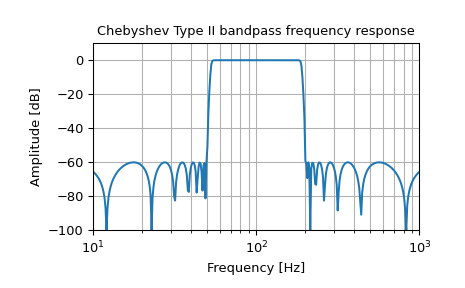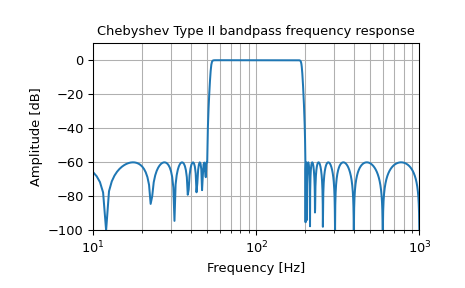iirfilter#
- scipy.signal.iirfilter(N, Wn, rp=None, rs=None, btype='band', analog=False, ftype='butter', output='ba', fs=None)[source]#
IIR digital and analog filter design given order and critical points.
Design an Nth-order digital or analog filter and return the filter coefficients.
- Parameters:
- Nint
The order of the filter.
- Wnarray_like
A scalar or length-2 sequence giving the critical frequencies.
For digital filters, Wn are in the same units as fs. By default, fs is 2 half-cycles/sample, so these are normalized from 0 to 1, where 1 is the Nyquist frequency. (Wn is thus in half-cycles / sample.)
For analog filters, Wn is an angular frequency (e.g., rad/s).
When Wn is a length-2 sequence,
Wn[0]must be less thanWn[1].- rpfloat, optional
For Chebyshev and elliptic filters, provides the maximum ripple in the passband. (dB)
- rsfloat, optional
For Chebyshev and elliptic filters, provides the minimum attenuation in the stop band. (dB)
- btype{‘bandpass’, ‘lowpass’, ‘highpass’, ‘bandstop’}, optional
The type of filter. Default is ‘bandpass’.
- analogbool, optional
When True, return an analog filter, otherwise a digital filter is returned.
- ftypestr, optional
The type of IIR filter to design:
Butterworth : ‘butter’
Chebyshev I : ‘cheby1’
Chebyshev II : ‘cheby2’
Cauer/elliptic: ‘ellip’
Bessel/Thomson: ‘bessel’
- output{‘ba’, ‘zpk’, ‘sos’}, optional
Filter form of the output:
second-order sections (recommended): ‘sos’
numerator/denominator (default) : ‘ba’
pole-zero : ‘zpk’
In general the second-order sections (‘sos’) form is recommended because inferring the coefficients for the numerator/denominator form (‘ba’) suffers from numerical instabilities. For reasons of backward compatibility the default form is the numerator/denominator form (‘ba’), where the ‘b’ and the ‘a’ in ‘ba’ refer to the commonly used names of the coefficients used.
Note: Using the second-order sections form (‘sos’) is sometimes associated with additional computational costs: for data-intense use cases it is therefore recommended to also investigate the numerator/denominator form (‘ba’).
- fsfloat, optional
The sampling frequency of the digital system.
Added in version 1.2.0.
- Returns:
- b, andarray, ndarray
Numerator (b) and denominator (a) polynomials of the IIR filter. Only returned if
output='ba'.- z, p, kndarray, ndarray, float
Zeros, poles, and system gain of the IIR filter transfer function. Only returned if
output='zpk'.- sosndarray
Second-order sections representation of the IIR filter. Only returned if
output='sos'.
See also
Notes
The
'sos'output parameter was added in 0.16.0.The current behavior is for
ndarrayoutputs to have 64 bit precision (float64orcomplex128) regardless of the dtype of Wn but outputs may respect the dtype of Wn in a future version.Array API Standard Support
iirfilterhas experimental support for Python Array API Standard compatible backends in addition to NumPy. Please consider testing these features by setting an environment variableSCIPY_ARRAY_API=1and providing CuPy, PyTorch, JAX, or Dask arrays as array arguments. The following combinations of backend and device (or other capability) are supported.Library
CPU
GPU
NumPy
✅
n/a
CuPy
n/a
✅
PyTorch
✅
✅
JAX
⚠️ no JIT
⛔
Dask
⚠️ computes graph
n/a
See Support for the array API standard for more information.
Examples
Generate a 17th-order Chebyshev II analog bandpass filter from 50 Hz to 200 Hz and plot the frequency response:
>>> import numpy as np >>> from scipy import signal >>> import matplotlib.pyplot as plt
>>> b, a = signal.iirfilter(17, [2*np.pi*50, 2*np.pi*200], rs=60, ... btype='band', analog=True, ftype='cheby2') >>> w, h = signal.freqs(b, a, 1000) >>> fig = plt.figure() >>> ax = fig.add_subplot(1, 1, 1) >>> ax.semilogx(w / (2*np.pi), 20 * np.log10(np.maximum(abs(h), 1e-5))) >>> ax.set_title('Chebyshev Type II bandpass frequency response') >>> ax.set_xlabel('Frequency [Hz]') >>> ax.set_ylabel('Amplitude [dB]') >>> ax.axis((10, 1000, -100, 10)) >>> ax.grid(which='both', axis='both') >>> plt.show()

Create a digital filter with the same properties, in a system with sampling rate of 2000 Hz, and plot the frequency response. (Second-order sections implementation is required to ensure stability of a filter of this order):
>>> sos = signal.iirfilter(17, [50, 200], rs=60, btype='band', ... analog=False, ftype='cheby2', fs=2000, ... output='sos') >>> w, h = signal.freqz_sos(sos, 2000, fs=2000) >>> fig = plt.figure() >>> ax = fig.add_subplot(1, 1, 1) >>> ax.semilogx(w, 20 * np.log10(np.maximum(abs(h), 1e-5))) >>> ax.set_title('Chebyshev Type II bandpass frequency response') >>> ax.set_xlabel('Frequency [Hz]') >>> ax.set_ylabel('Amplitude [dB]') >>> ax.axis((10, 1000, -100, 10)) >>> ax.grid(which='both', axis='both') >>> plt.show()
